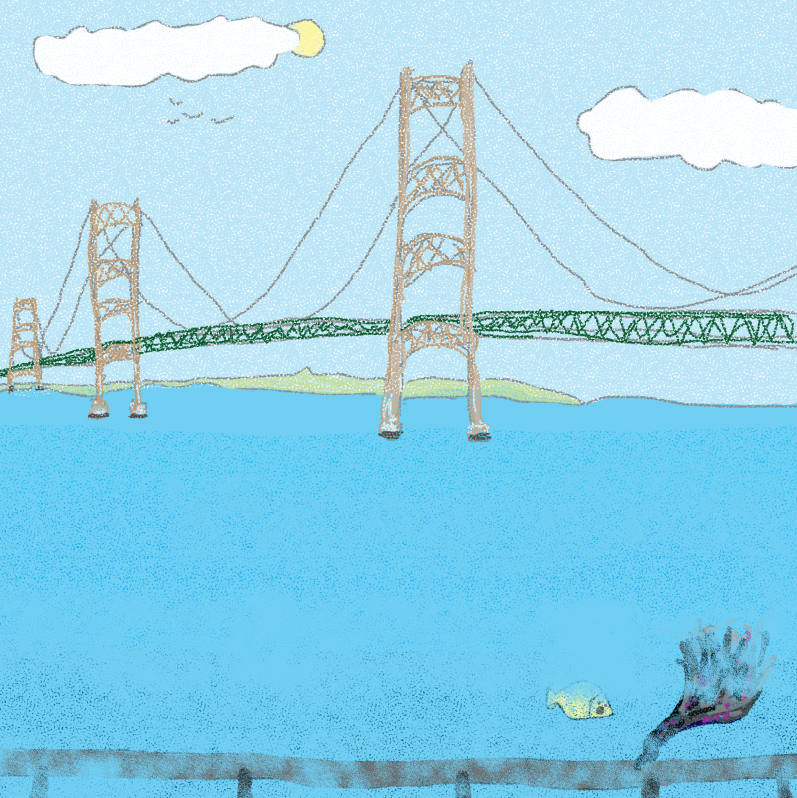Profile of a Pipeline and Why It Needs To Go
In the heart of the Great Lakes, the waters of Lake Michigan and Lake Huron combine at the Straits of Mackinac. A five mile stretch of clear freshwater rests between Michigan’s Upper and Lower Peninsula – a beautiful sight to behold.
The Straits of Mackinac are more than a pretty view – they are a body of water with a monster lurking beneath the surface. Hidden by the freshwater, almost directly under the Mackinac bridge, rests an aging pipeline capable of drastically altering the lakes’ ecosystem and everything around it with one leak.
This is Enbridge Line 5.
Line 5 was built in 1953. It consists of two parallel pipelines running under the water, about 1,000 feet apart. Its placement under the Straits is opportune and convenient for carrying crude oil from Ontario, Canada to Superior, Wisconsin, where Line 5 joins with Line 6 and continues into Canada.
Its placement is also opportune for transforming our Great Lakes from a thriving freshwater ecosystem to a oil soaked mess. As we know, oil and water don’t mix. But this transformation is more likely than one might think.
Enbridge as a company doesn’t have a great track record with leaks. In July of 2010, as all attention was on the Deepwater Horizon spill, Enbridge Line 6B ruptured. A six foot horizontal gash released approximately 843,000 gallons of oil into a tributary of the Kalamazoo River and required more than four years to clean up. It was the largest inland oil spill in our country’s history.
The spill was devastating for the community and environment around the river. Families were relocated, the river and its wildlife was drastically changed, and the cost to clean up this mess was more than $1.2 billion. With this spill, residents of Michigan were alerted to the dangers of these hazardous pipelines that had previously gone unnoticed.
Oil spills at the hands of Enbridge aren’t a one time thing. According to the Polaris Institute, who took their data from Enbridge’s own reports, more than 804 oil spills occurred between 1999 and 2010. The Kalamazoo spill in 2010 wasn’t the first time Enbridge was responsible for a leak with disastrous consequences, and it won’t be the last.
“The reported leak highlights the danger this pipeline poses to the Great Lakes,” Andy Buchsbaum said in a press release, about the Kalamazoo River oil spill. Buchsbaum is the vice president for conservative action at the National Wildlife Federation, an organization which works for environmental preservation. “Even after all the attention to Enbridge’s Line 5 over the past two years, Enbridge and the government couldn’t prevent the leak in this pipeline, which carries up to 23 million gallons a day of oil through the Straits of Mackinac. It demonstrates that eventually, all pipelines leak – the question is when and how much.”
Enbridge Line 6B is the pipeline that brought this issue to light. However, it is far from the only pipeline endangering our environment and our state: Enbridge has a network of pipelines carrying oil throughout the Great Lakes region. The one with the most potential risk runs through the Great Lakes themselves. The Line 6B spill had disastrous effects, but a spill by Line 5 would be worse.
The Great Lakes make up the largest body of fresh water of the world. We need to put two and two together. This is our planet’s greatest supply of freshwater; one fifth of the total freshwater in the world. This is a pipeline operated by a company responsible for the largest inland oil spill ever to take place in our country. Do we want a company with a history like that to be risking the future of our lakes?
No. Definitely not.
Enbridge doesn’t seem inclined to remove this pipeline, however. On their website, they state how they have been a crucial part of Michigan’s economy for more than 60 years. In a slightly ominous message, their intention to remain part of it is told as well: “…with 250 employees and contractors, we plan on being part of it for many more.”
To be fair, there have been no problems with the pipeline. Yet. But it is more than 60 years old and has never been replaced, despite having been made to last only 50 years. It is a ticking timebomb.
As mentioned above, the placement of this pipeline is ideal for dispersing oil if it were to leak. The turbulent waters of the Straits of Mackinac would carry the oil throughout the Straits and to the vulnerable waters of Lake Huron and Michigan. The oil would travel fast and go far. Under the Straits is the worst place for an oil spill in the Great Lakes. This is where a spill would be the most devastating.
Studies have been done to see exactly where this oil would go. According to a study of the effects of a pipeline spill conducted by Dave Schwab, the best case scenario would be a 1.5 million gallon oil spill, and that’s assuming only one of the twin pipelines ruptured, and it was shut off by Enbridge immediately. The worst case scenario: around 60% of Lake Huron’s open water is affected, and 15% of Lake Michigan’s. More than 17,000 square miles of water are at risk, and over 700 miles of coastlines.
Because the existence of these pipelines aren’t well known, information about them follows a disturbing pattern. We never hear about the pipelines – until they spill. This shouldn’t be the case with Enbridge Line 5. The public’s first encounter with this pipeline shouldn’t be when they hear about the disastrous oil spill and the consequences of it.
We need to remove this pipeline. The future of our freshwater, environment and way of life depend on it.










